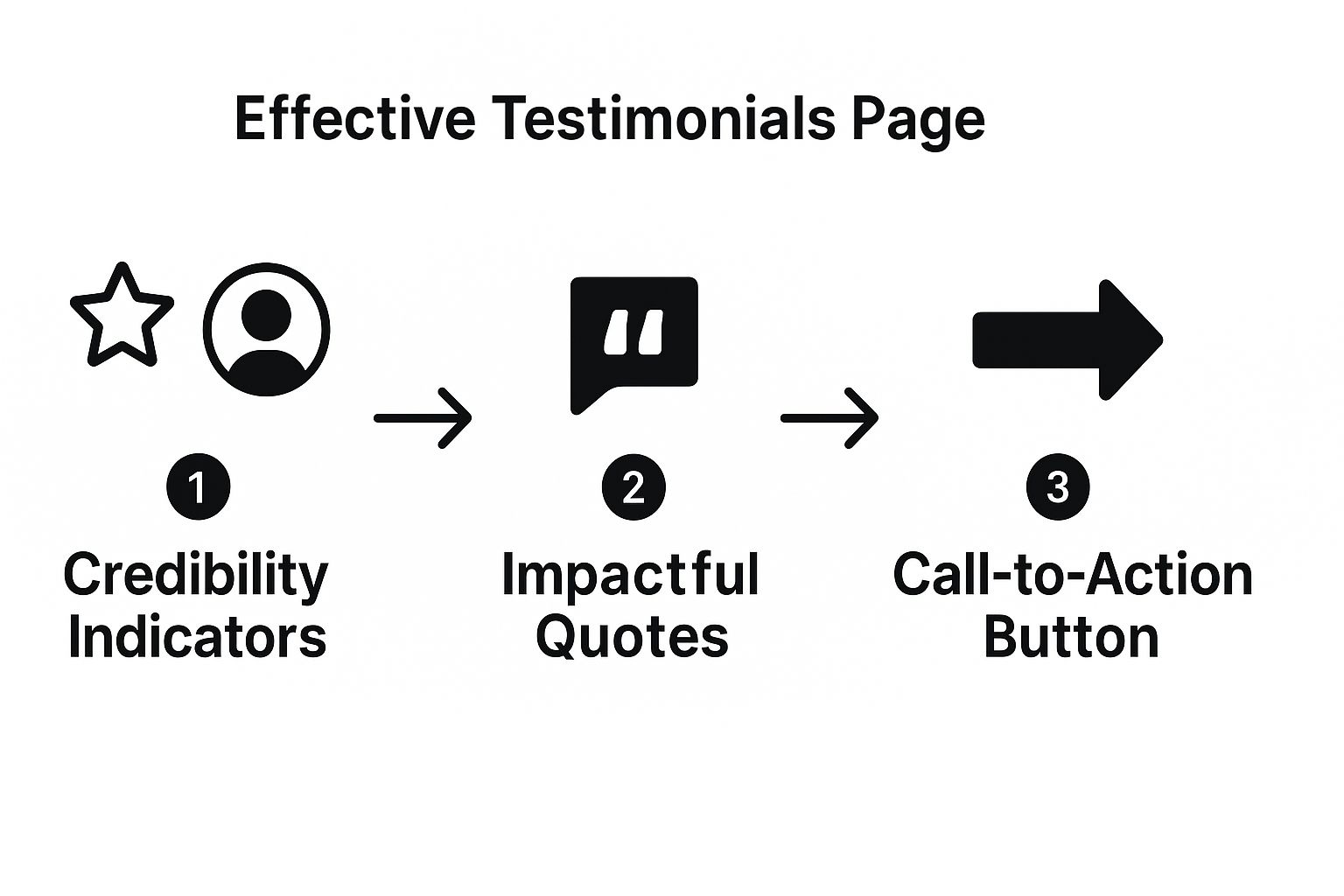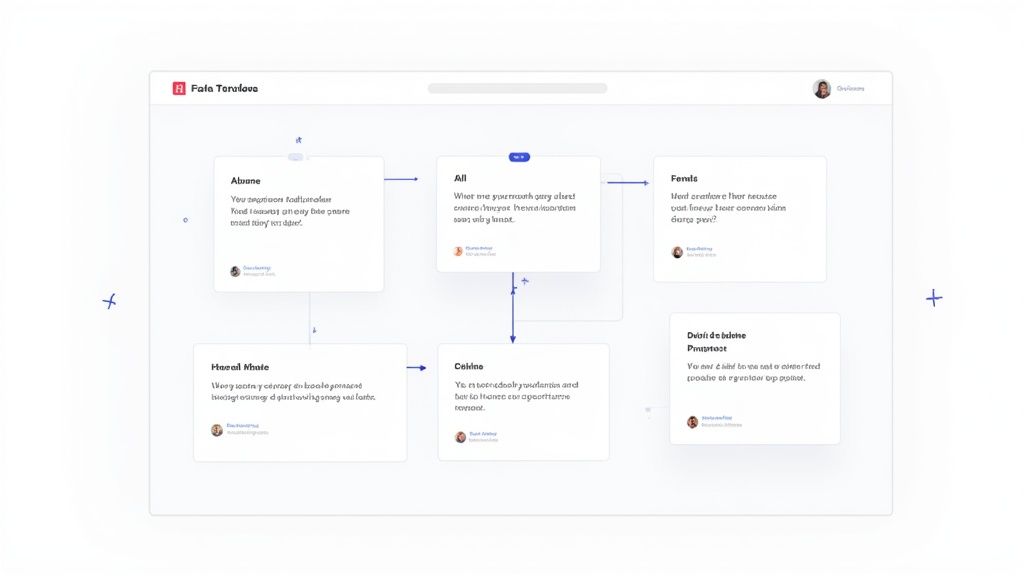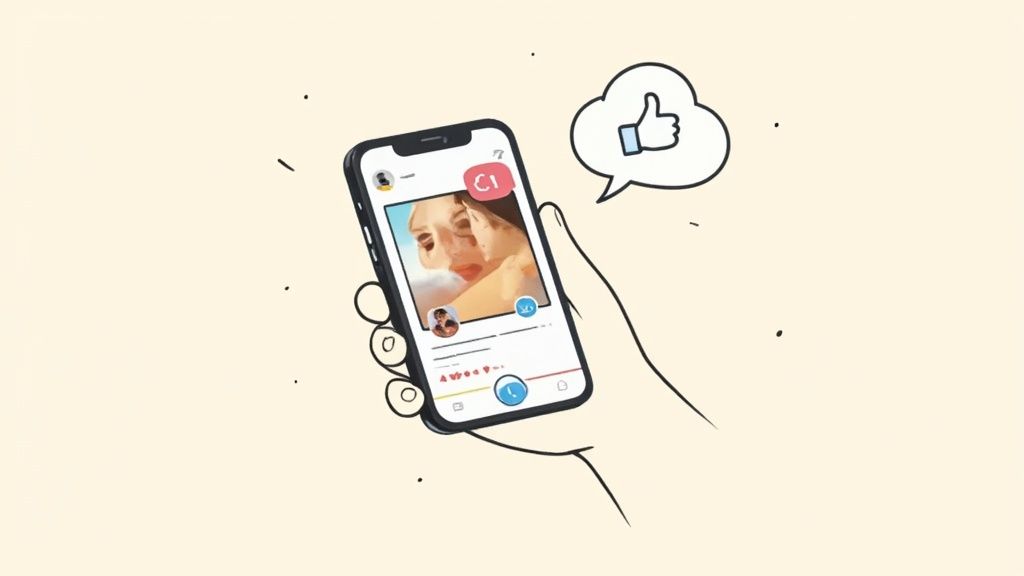High-Converting Testimonials Page Design
A great testimonials page design is more than just a wall of quotes. It's a strategic tool that builds trust and nudges visitors toward making a purchase. When you get it right, simple customer feedback transforms into a powerful asset that smashes through a potential buyer's doubts with authentic social proof.
Why Your Testimonials Page Is a Conversion Powerhouse

So many businesses treat their testimonials page like an afterthought—a box to check on their website launch list. This perspective completely misses the massive opportunity sitting right in front of them. A well-designed page isn’t just a collection of nice words; it’s a strategic play to overcome customer objections before they can even fully take root.
Think of it this way: your testimonials page is like having your happiest customers on standby, 24/7, ready to reassure anyone who’s on the fence. It's a dedicated space where you can let real people do the selling for you. In a world where everyone is skeptical of slick marketing messages, the authentic voices of actual users cut right through the noise.
The Psychology of Social Proof
At its core, a testimonials page works because of a powerful psychological trigger called social proof. When people feel uncertain about a decision, they instinctively look to the actions and experiences of others to guide their own choices. A thoughtfully designed testimonials page delivers exactly that.
It serves several critical functions for your business:
- Builds Instant Trust: Seeing that real people—and companies—have already found success with your product lowers the perceived risk and builds immediate confidence.
- Addresses Specific Doubts: You can strategically feature testimonials that tackle common objections head-on, whether it’s about price, complexity, or a very specific use case.
- Humanizes Your Brand: Putting faces, names, and stories to your customer base makes your company more relatable and feel less like a faceless corporation.
Turning Trust into Revenue
This trust isn't just a feel-good metric; it has a direct, measurable impact on your bottom line. An effective testimonials page is a key piece of a successful sales funnel, helping to nurture leads and validate their decision-making process. The goal is to move beyond a simple list of quotes and create a compelling narrative of customer success.
A testimonials page is your silent salesperson. It validates your claims, eases buyer anxiety, and provides the final nudge a prospect needs to convert. Neglecting its design is like leaving money on the table.
Understanding the core principles of conversion rate optimization strategies is essential for getting the most out of your page. The data doesn't lie: a staggering 72% of customers say they trust a business more after reading positive reviews, which can boost sales in a big way. This just goes to show the immense power of social proof in shaping consumer confidence and driving purchasing decisions.
How to Gather Testimonials That Genuinely Persuade
Let's be honest, a beautifully designed testimonials page falls completely flat if the content is weak. Vague praise like "great service" or "love the product" just doesn't have the punch to convince a skeptical prospect. The secret is to stop passively waiting for feedback and start proactively gathering specific, story-driven testimonials.
This whole process really kicks off by asking the right questions. Instead of a generic "How did we do?" prompt, you need to guide your customers toward providing the details that actually matter to potential buyers. The goal here is to get them to tell a story about their transformation.
Asking Questions That Elicit Stories
Your outreach should be all about the "before and after." Ask questions that get customers thinking about their journey with your product or service. This simple shift in framing turns a basic review into a compelling mini case study.
Here are a few powerful questions I always recommend:
- What specific problem were you trying to solve when you found us? This sets the stage perfectly and helps prospects immediately identify with the customer's initial pain point.
- What was the single biggest result you achieved after using our product? This pushes for those crucial, quantifiable outcomes, like a 25% increase in productivity or a reduction in support tickets.
- What feature do you find most valuable, and why? This is great for highlighting specific product benefits through the lens of a real user.
- What would you tell someone who is on the fence about choosing us? This question directly tackles potential objections and gives you a powerful peer-to-peer recommendation.
For more inspiration, we've put together a guide on customer testimonial templates that gives you structured ways to request this kind of valuable feedback.
Remember, the most persuasive testimonials aren't just about your product; they're about your customer's success. Frame your questions to make them the hero of the story.
The best testimonials follow a clear, persuasive path. This infographic really breaks down the essential flow, from establishing credibility all the way to prompting action.

As you can see, the journey starts with trust signals like a photo and name, moves to the impactful quote, and wraps up with a clear call-to-action that guides the visitor forward.
Methods for Collecting Authentic Feedback
Once you know what to ask, you need an efficient way to actually gather the responses. Don’t just rely on one method. A mix of approaches will help you capture feedback at different points in the customer lifecycle.
Using a multi-channel strategy ensures you have a steady stream of fresh, relevant content for your testimonials page design.
Consider putting these collection points in place:
- Targeted Email Outreach: Personally contact your most successful or long-term customers. A personalized request that acknowledges their success makes them far more likely to respond with a thoughtful, detailed testimonial.
- Post-Purchase Surveys: Automate a simple survey that triggers a week or two after a purchase or after they hit a key milestone. Use your story-driven questions here to capture their thoughts while the experience is still fresh.
- Leverage Video Platforms: Use tools that make it dead simple for customers to record short video testimonials. Video adds a powerful layer of authenticity that text alone just can't match.
No matter which method you use, always get permission to use their words and ask for a high-quality headshot. This simple step adds a face to the name, dramatically increasing the credibility and impact of every single testimonial on your page.
Core Design Principles for a High-Impact Layout

A great testimonials page is so much more than a dumping ground for quotes. Its design communicates professionalism and builds trust long before a visitor reads a single word. Think about it—a clunky, crowded layout can kill the credibility of even the most glowing customer stories, making your brand feel dated or disorganized.
The goal here is to create an experience that feels effortless and guides the eye exactly where you want it to go. This isn't just fluffy design talk. A staggering 94% of first impressions are directly tied to a site's visual design. Users form an opinion in as little as 0.05 seconds, which means your layout has an instant impact on whether someone sticks around or bounces.
A clean, professional testimonials page design isn't just nice to have; it's a non-negotiable part of building immediate trust. For a deeper dive into how design shapes perception, check out the insights from famewall.io.
Establish a Clear Visual Hierarchy
Visual hierarchy is all about telling your visitor's eyes where to look first. Without it, everything on the page screams for attention at the same time, and the result is that nothing gets seen. Your most impactful testimonials—the ones with jaw-dropping results or from big-name clients—need to stand out.
You can pull this off with a few simple techniques:
- Size and Scale: Make your best pull-quotes or customer headshots just a little bit larger than the others. The eye is naturally drawn to the biggest element on the page.
- Color Contrast: Use a bold brand color for the heading or the person's name on a key testimonial. It’s a simple trick to make it pop off the page.
- Strategic Placement: Put your strongest social proof "above the fold" or at the very top of a grid. It should be the first thing people see when they land.
Embrace the Power of White Space
One of the biggest design mistakes I see is cramming way too much onto one page. Overloading the layout with text and images creates visual chaos, making it nearly impossible for visitors to actually read and absorb the content.
This is where white space—or negative space—comes in. It's the empty area around your design elements. Using it generously makes your content more legible and gives the whole page a more sophisticated, premium feel. It helps separate individual testimonials, giving each customer's story its own stage to shine on. To make sure your page is both functional and beautiful, it helps to understand some general web design principles.
Good design is about what you leave out as much as what you put in. Ample white space reduces cognitive load and allows your most persuasive content to stand out.
Finally, every single element on the page should point the user toward a next step. A powerful testimonial should be immediately followed by a clear, compelling call to action that cashes in on that positive momentum.
Don't make visitors hunt for what to do next. Weave in buttons that lead them to a product page, a demo request, or a free trial. For guidance on crafting CTAs that get clicked, check out our detailed article on call-to-action button examples. This final piece of the puzzle is what turns your page from a simple showcase into a true conversion tool.
Structuring Your Page for Scannability and Trust
Let’s be honest—people don’t read websites anymore. They scan. If your testimonials page is just a giant wall of text, you’ve lost before you’ve even started. Prospects are busy, and their attention is fleeting.
Your page needs to be built for the way real people browse. The goal is to let a visitor find the exact piece of proof they’re looking for in seconds. If a potential customer is worried about a steep learning curve, they should be able to spot a testimonial from a non-technical user who found your product a breeze to set up.
Organize for Instant Relevance
The single biggest win for scannability is categorization. Ditching a random, chronological feed of quotes in favor of logical groups turns your page from a messy junk drawer into a precision tool.
Instead of making visitors hunt for relevance, serve it up to them on a silver platter.
Consider grouping your testimonials in a few smart ways:
- By Product or Service: Essential if you have multiple offerings. Let visitors filter down to see praise for the specific solution they’re evaluating.
- By Customer Pain Point: This is powerful stuff. Group stories around the problems you solve, like "Needed to Cut Down on Manual Data Entry" or "Struggling to Keep the Team Aligned."
- By Industry or Role: Absolutely critical for B2B. A marketing director doesn’t care how a CFO uses your tool; she wants to see testimonials from other marketers.
This approach immediately shows a visitor that you get their world and have a track record of helping people just like them.
Use Visual Cues to Guide the Eye
Once your testimonials are organized, you need to use design to break up the content and pull out the juiciest bits of information. These visual signposts make the page feel less intimidating and draw the eye straight to the money quotes.
Think of these elements as your page’s visual architecture:
- Compelling Subheadings: Don’t just use the customer’s name. Pull out the most impactful phrase from their quote and make that the headline. Something like "Our User Engagement Shot Up by 40%" is way more effective.
- Pull-Quotes: For longer case studies or video testimonials, grab the single most powerful sentence and blow it up. Display it in a larger, stylized font so scanners get the core message without having to watch or read the whole thing.
- Star Ratings: The 5-star system is a universal language for quality. Pairing a star rating with a text review gives an instant visual indicator of satisfaction, adding a familiar layer of trust.
To really maximize the impact of each testimonial, there are a few key ingredients that build credibility and make the social proof feel authentic. Without these, even a great quote can fall flat.
Here’s a breakdown of the essential elements that build trust and make your testimonials more persuasive.
Key Elements for Building Trust in Testimonials
| Element | Why It Matters | Best Practice Example |
|---|---|---|
| Customer Headshot | Puts a real face to the name, making the testimonial instantly more human and relatable. It proves a real person stands behind the words. | A professional, clear, and friendly-looking photo of the customer. |
| Full Name and Title | Adds a layer of professional credibility. "Jane Doe, Marketing Director" is far more powerful than just "Jane D." | Jane Doe, Marketing Director at Acme Corp |
| Company Name & Logo | Lends the authority of the customer's company to your brand, especially if it's a well-known name in your industry. | Include the company logo next to their name and title for quick brand recognition. |
| Specific Results | Vague praise is forgettable. Hard numbers and specific outcomes make the benefits tangible and believable. | "…which helped us increase our lead conversion rate by 27% in the first quarter." |
| The "Before" State | Highlighting the customer's pain point before they found your solution makes the "after" state more dramatic and relatable. | "We were struggling with disorganized spreadsheets and missed deadlines before..." |
By consistently including these elements, you transform a simple quote into a comprehensive piece of social proof. It’s no longer just a nice thing someone said; it’s a credible story from a real person at a real company who achieved a real result. That’s what builds the kind of trust that drives conversions.
Your page structure should do the heavy lifting. By organizing testimonials logically and using clear visual cues, you make it effortless for visitors to find proof that speaks directly to their needs. That’s the foundation of a high-converting page.
Moving Beyond Text with Advanced Testimonial Formats

Let’s be honest, static text quotes are the bare minimum. They’re a great start, but the best testimonial pages I've seen create an experience that’s much richer and far more convincing. To really grab a visitor’s attention, you have to think beyond simple blocks of text.
The smartest brands are already moving toward more dynamic formats. They’re using video, in-depth stories, and user-generated content to inject a serious dose of authenticity. This isn’t just a trend; it’s a response to changing expectations. For example, a staggering 70% of Gen Z users now expect websites to intuitively know what they want. You can read more about how testimonial pages are adapting on webstacks.com.
This means a modern, high-impact page needs a mix of formats, letting visitors choose how they want to engage with your success stories.
The Unmatched Authenticity of Video Testimonials
There’s a reason video is the undisputed king of social proof. Seeing and hearing a real person share their experience creates an immediate, powerful connection that text just can’t touch. A video testimonial feels raw and genuine, allowing a customer's real personality and enthusiasm to shine through.
And you don't need a Hollywood budget to pull this off. In fact, authentic, user-generated videos shot on a phone can often feel more trustworthy than overly polished corporate productions.
Here are a few tips I've learned for getting great video testimonials:
- Make it dead simple. Use tools that let customers record and submit videos straight from their phone or laptop. The less friction, the more likely they are to actually do it.
- Give them easy prompts. Guide them with the same story-driven questions you’d use for written reviews. Ask about their life "before" your product and the specific results they saw "after."
- Keep it short and sweet. Aim for videos that are 60-90 seconds long. That’s the sweet spot—long enough for a compelling story, but short enough to keep someone’s attention.
For more on this, check out our guide on using video on your landing pages. Many of the same rules apply here.
Telling a Deeper Story with Case Studies
While a quick quote or video offers a great snapshot, a case study lets you dive deep and tell a complete success story. This format is an absolute must for B2B companies or anyone with a complex product, as it gives you the space to unpack the tangible, data-backed results your customer achieved.
A killer case study almost always follows this simple but powerful narrative structure:
- The Challenge: Start by clearly outlining the specific problem the customer was wrestling with before they found you.
- The Solution: Explain exactly how your product or service was used to tackle that challenge.
- The Results: This is the money shot. Showcase the measurable outcomes using hard numbers—percentages, revenue figures, or hours saved.
By laying out a clear problem-solution-result story, a case study turns one customer's success into a repeatable blueprint that a new prospect can easily see themselves in.
This format delivers the in-depth proof that more analytical buyers crave, turning a simple testimonial into a seriously powerful sales asset.
Frequently Asked Questions About Testimonials Page Design
Even with a solid game plan, you're bound to hit a few snags during the design process. Getting stuck on the small stuff can kill your momentum, so let's tackle some of the most common questions that pop up when you're trying to build a killer testimonials page.
Think of this as your quick-reference guide for those final, crucial decisions. Getting these details right is what separates a pretty good page from one that genuinely converts.
How Many Testimonials Should I Put on My Page?
This is a classic case of "quality over quantity." While there’s no magic number, a great starting point is between 10 to 15 really strong, diverse testimonials. If you have fewer than five, the page can look a bit thin and unconvincing. On the flip side, cramming in over 30 can be overwhelming and actually dilutes the power of your best stories.
The real key here is variety. You want a mix that showcases different:
- Use Cases: Show how your product solves different problems for different people.
- Customer Segments: Feature a mix of small businesses, enterprise clients, and folks from different industries to widen your appeal.
- Formats: Blend text quotes with video testimonials and maybe toss in a couple of short case studies to keep things interesting.
The goal isn't to dump every nice comment you've ever received onto one page. It’s to curate a gallery of success stories that, together, answer a prospect's biggest questions and crush their objections.
Should I Create a Dedicated Testimonials Page?
Yes, without a doubt. It’s smart to sprinkle testimonials across your homepage and product pages, but a dedicated page serves a critical function. It’s the central hub for all your social proof, making it incredibly easy for prospects who are seriously considering a purchase to do their homework.
A dedicated page gives you the space to organize and categorize your testimonials in ways you just can't do elsewhere. This structure lets visitors quickly find stories from customers just like them, which is a huge step in the buying journey and a core principle of effective testimonials page design.
Can I Edit Customer Testimonials?
You can—and should—edit for things like clarity and length, but you absolutely cannot change the original meaning. It's perfectly fine to fix a typo or a minor grammatical error. It’s also okay to trim a longer quote down to its most powerful sentence.
The trick is to be transparent about it. A simple, professional way to handle this is to send the edited version back to the customer for their final sign-off. A quick email that says, "Hey, we've shortened this a bit for our website. Does this still capture your experience correctly?" builds goodwill and keeps everything authentic.
Ready to stop guessing what works? Pages.Report gives you access to proven design patterns from over 368 successful SaaS landing pages. Analyze what the best in the business are doing, get actionable insights, and build a testimonials page that truly converts. Start learning from the winners today at https://pages.report.
